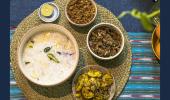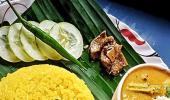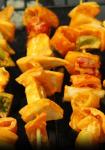Kurujathaka Khaja is a dry, crispy sweet delicacy from Puri, Odisha. It is a significant part of the mahaprasad offered at the Jagannath Temple.
Khaja have been listed by TasteAtlas as among the best 'sweet pastries' from around the world.
This chewy snack can double up for a light dessert. You will shops lined up at the Bada Danda thoroughfare outside the temple premises selling fresh khajas sold in woven baskets.
If you want to try this wheat-based recipe at home, fry it in pure ghee for the most delectable aroma and taste.

Kurujathaka Khaja
Makes: About 30 pieces
Ingredients
- 1 cup aatta or whole wheat flour
- 2 tsp ghee or melted unsalted butter
- ¼ tsp ajwain or carom seeds
- ¼ tsp lightly crushed saunf or fennel seeds
- Pinch salt
- Ghee or oil, for deep frying the khaja
For the sugar syrup or chashni:
- ½ cup sugar (please see the note below)
- ¼ cup water
Method
- In a mixing bowl, combine the whole wheat flour, ghee, carom seeds, crushed fennel seeds, salt.
Mix well, using your fingertips until the mixture resembles coarse crumbs and the ghee is well incorporated.
Gradually add the water, a little at a time, and knead to form a stiff, tight dough.
Do not add too much water; the dough should not be soft.
Cover and let it rest for at least 15 to 20 minutes.
For the sugar syrup or chashni:
- In a saucepan, combine the sugar and the water and bring to a boil, over medium heat, stirring until the sugar dissolves.
Let it simmer over low heat until it reaches a two-string consistency (please see the note below). - Take off heat and keep warm.
Rolling and frying the khaja:
- Divide the rested dough into small, equal-sized portions, about the size of small limes.
Roll out one portion of the dough, into a small, thick disc or puri, about 2-3 inches in diameter; thicker than a regular puri.
Repeat for the rest of the portions. - Heat the ghee or oil in a deep frying pan or kadhai over low heat to ensure the khajas cook through and become crispy.
Gently slide a few rolled puris into the hot ghee.
Fry until golden brown and crisp on both sides.
Frying these puris will take longer than regular puris, so be patient :)
Drain using a slotted spoon and transfer to a tissue or paper towel-lined plate. - While the fried khajas are still warm, immerse them into the warm sugar syrup.
Let them soak for a few minutes on each side until they absorb the syrup; they should be coated but still retain their crispness.
Drain the soaked khajas from the syrup onto a plate to dry.
As they cool, they will become slightly dry and the sugar syrup will crystallise a bit on the surface. - Once cooled and slightly dried, serve.
Store at room temperature, in an air-tight container; they have a long shelf life.
Shristi's Note: Knead the dough such that it is the drier side for crispy and crunchy khajas.
Instead of sugar, traditionally powdered rock sugar/mishri is used for its unique taste. If using powdered rock sugar in the syrup, when you dunk the khaja into the syrup, the absorption might be quicker.
Two-thread or two-string sugar syrup:
It is sugar syrup viscous enough to pass the two-thread or two-string test.
It is important to keep testing for consistency while the sugar syrup is boiling.
The test for this is: Dip a spatula, preferably wooden, into the boiling sugar syrup and take out.
Some syrup would have coated the spatula.
Let it cool.
Touch the cooled syrup with your forefinger.
Some syrup will come onto your finger.
Touch that with your thumb and separate thumb from forefinger.
When two little continuous delicate threads are formed by the syrup, when the coated forefinger is pulled away from your thumb, you have a two-thread consistency sugar syrup.











